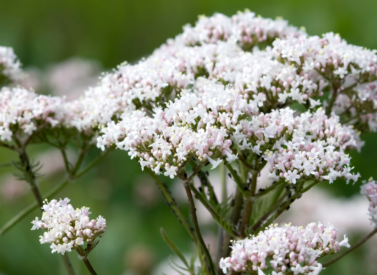Scientific Name: Valeriana officinalis
Constituents:
- Iridoid esters: valepotriates (isovaltrate & valtrate)
- Sesquiterpenes: valerenic acid, valerenal & valeranone
- Volatile oil (isovaleric acid, camphene & borneol)
- Alkaloids (actinidine, valerine, valerianine & chatinine)
- Flavonoids (linarin, acacetin, 6-methylapigenin, hesperidin)
- Polyphenolics (chlorogenic acid)
- Lignans (hydroxypinoresinol)
- Free amino acids (e.g. GABA, tyrosine, arginine, and glutamine)
- Tannins
- Resin & Gum
Medicinal actions:
- Analgesic
- Antispasmodic
- Antimicrobial
- Bitter
- Carminative
- Nervine Relaxant & Sedative
- Hypotensive
Mechanism of Action & Pharmacology:
- For a time valepotriates were thought to be the sole active constituents, however more than 150 constituents have been identified and none appear to be solely responsible for therapeutic effects, suggesting compounds may act synergistically. Volatile oil, valepotriates, valerenic acid and derivatives all appear to contribute towards nervous system depressant & sedative activity.
- Volatile Oils & Sesquiterpene compounds (valerenic acid, valerenal & valeranone) appear to play a significant role. Animal studies have shown valerenic acid to cause a decrease of locomotility and affect motor test performance in a manner similar to pentobarbital and prolonging sleeping time induced by it. Similarly, valeranone was found to affect motor test performance, prolongs barbiturate hypnosis, and demonstrate antispasmodic, anti-convulsive and anti-ulcer activity.
- Inherit content of the inhibitory neurotransmitter gamma-aminobutyric acid (GABA) could directly cause sedation (although concerns exist regarding its bioavailability), while concurrently inhibiting the enzyme-induced breakdown of GABA (catabolism) in the brain via valerenic acid derivatives and chlorogenic acid. Valerenic acid also appears to allosterically modulate GABA-A receptors in vitro and in vivo, and its derivatives have been shown to interact with interact GABA receptors in vitro.
- Valepotriates appear to valepotriates exert a regulatory effect on the autonomic nervous system. Valepotriates can decompose into other compounds known as baldrinals (note that high levels of baldrinals in the herb could indicate less valepotriates and a potentially poorer quality herb, but baldrinals may also have yet unknown bioactive effects in the body). Paradoxical stimulant effects may be due to a high sensitivity to valepotriates.
- Alkaloids (chatinine & valerine) inhibition Gram-positive bacteria and have hypotensive effects.
- Lignan (hydroxypinoresinol) has been found to bind to benzodiazepine receptors and has medium to low affinity for 5-HTP receptors in vitro.
- Flavonoid 6-methylapigenin is anxiolytic, flavanone glycoside hesperidin is sedative and sleep-enhancing, and flavone glycoside linarin has demonstrated sedative and sleep-enhancing properties in mice.
Pharmacy:
- Decoction
- Tincture
- Capsules
- Note: Iridoid constituents (Valepotriates) rapidly hydrolyze in water extracts, are perhaps best used in capsule or tincture form
Safety & Toxicity Concerns:
- 10% of individuals will react paradoxically and be stimulated by Valerian causing various CNS disturbances including excitability & agitation, insomnia & headache, and cardiac disturbances.
- Potential for allergic hypersensitivity and gastric upset.
- Avoid in conditions where sedation could pose a danger. Can aggravate sensations of fatigue or drowsiness at higher doses, and overdose may result in blurred vision or visual disturbance, palpitations, headache, nausea, restlessness, and spasmodic movements, bradycardia, arrhythmia and decreased intestinal motility
- Use caution in history of cardiovascular or liver disease,
- Avoid in pregnancy & lactation (controversial) and abrupt discontinuation due to possible withdrawal syndrome.
Interactions:
- Potential additive effects with CNS depressants (e.g. benzodiazepines, barbiturates and alcohol) and for CYP3A4 inhibition.








